-
We are currently performing site maintenance, parts of civfanatics are currently offline, but will come back online in the coming days. For more updates please see here.
You are using an out of date browser. It may not display this or other websites correctly.
You should upgrade or use an alternative browser.
You should upgrade or use an alternative browser.
In the Name of the Most Serene Empire; a EU3 IN Venice AAR
- Thread starter Tani Coyote
- Start date
Tani Coyote
Son of Huehuecoyotl
- Joined
- May 28, 2007
- Messages
- 15,193
I can't help but wonder if Spain and Portugal are going to control all of the Americas at this rate.
Castile(we might as well call it Spain though, as the pwnage of French Iberia and Aragon has allowed them to control most of it) has already developed the "spam war on pagans" method... they've already destroyed the Maya, as I know by the fact they were at war with the Maya, and now there's no truce...
Portugal is growing quite fast as well, what with the Portuguese Canada and Brazil.
I also have to wait a few decades I think before I can get Quest for the New World, after 5 ideas, things seem to become quite expensive. Luckily I have so many universities, but I must take more to beat my enemies.
After I'm done tearing France and Germany(and possibly England; they likely will guarantee the mainland at some point, though that's no issue, as England has consistently been around -3 stability the ENTIRE game) apart, I will begin to push into Iberia, probably through a warning of Castile(do you get an alliance call with warnings? Since every time I've been warned, the enemy always intervenes). Castile has many large doomstacks in their homeland, but I have more total troops from what I can see. The only issue will be shipping them all to the war front... obviously a large military buildup will be in order.
Other than that, my colonial range continues to gradually increase, and EVENTUALLY, eventually, I'll be able to reach the Caribbean, Quest for the New World or not.

All the while ignoring the fact that the Roman Empire is re-forming.
As I've said before... totally non-intentional...
 I'm aiming for the Empire of Charlemagne, honest!
I'm aiming for the Empire of Charlemagne, honest!  *kicks all the Balkan and Islamic provinces off to the side...*
*kicks all the Balkan and Islamic provinces off to the side...*IronMan2055
Korra 2011
Continental Europe north of Iberia is getting to look essentially Italian with only regional pockets standing in the way.
Tani Coyote
Son of Huehuecoyotl
- Joined
- May 28, 2007
- Messages
- 15,193
Chapter XXXI: Peaceful Years(1527-1530)
Spoiler :
1527
January, with peace fully in effect, Morocco's ruler met with the Italian Emperor, wanting to discuss Morocco's future vassalage. Emperor Vittore I said he was willing to abandon his suzerainty over the region, only to find the Moroccan Despot kneel before him and kiss his feet, begging the Italians to continue to protect Morocco. The Castilians had claims to the Morocco's capital, and if Italy abandoned them, they surely would attack. The Emperor took this into consideration... and therefore agreed to keep the Moroccans under Italian overlordship.
And so, days into the new year, Italy and Morocco signed a formal alliance, adding Morocco's 3,000 infantry to Italy's arsenal.
Mere days afterwards, Novgorod broke away from Italy's alliance. Ah well.
May, Vittore I instituted the Great Legal Reform, placing high courts - and their headquarters, the courthouses - in several key cities: Alexandria, Venice, Genoa, Munich, Larissa, Angora, and Oran. Vittore I was steadily reforming the Empire into several distinct provinces, with these cities as some of the makeshift capitals.
Sweden annexed Norway later into May, acquiring both Oslo and Iceland.
July, Wurtemburg was finally re-converted to Catholicism.
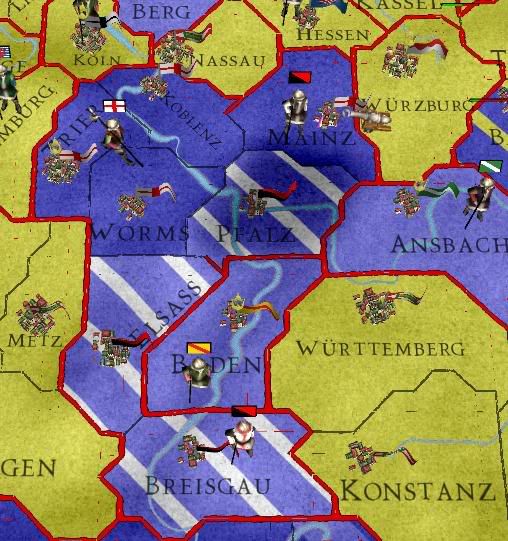
Meanwhile, the second-strongest state in Germany(after a far cry from Italy), Trier, was engaged in a brutal civil war. While the state had been founded in the wake of the collapse of the Reformed Austrian Empire, with Protestants wanting to break away from the Reformists, only a few Reformist notables decided to align with the government in Trier, and managed to use their influence to prevent any rebellions.
With their death, however, a civil war erupted between the state-supported Protestants and the rebel Reformists, who wanted either a country of their own, to have greater influence in Trier, or above all, impose their will upon the entire country. So long as the heretics destroyed eachother, Vittore I, the self-proclaimed leader of the Catholic world(in secular matters), was satisfied.
Publicly, the Emperor stated his sharp disagreement with the Reformists for force-converting the Catholics of Breisgau(one of the last vestiges of Catholicism within the former Austrian Empire), but secretly, he hoped they would tear eachother apart and leave a power vacuum Venice could fill. However, he said he would remain neutral in the conflict unless rebels crossed into the territories of other states in the Holy Roman Empire.
September, Mecklenburg - the province - was converted to Catholicism.
As well, the Reformists in Trier seized power over the country.
Late September, Simone Rovigo was orderd to invade Wurzburg's territory to destroy Reformed Zealots in the area, and after finishing them off, to move north against Oldenburger nationalists.

October, the Savoyards finally gave up power in exchange for administrative powers over their former territory. For some odd reason, they styled themselves "Venice" in the treaty... (x submits to Italy is an event that allows Italy to inherit country x if they have less than 4 provinces. The idea is that to thwart the formation of Italy, they should have expanded enough by that time to be a counter to Italian might. As a downside to this free inheritance, however, there is one decentralisation point per event, so it pays off to get rid of most Italian states)
With Savoy's territories firmly under Italian control, the French provinces were finally linked up with Italy proper. To counter the loss of prestige, Naxos and Macedonia were added to the Holy Roman Empire's provinces.
October also saw the elimination of the Reformed Zealots in Wurzburg.
November, the Oldenburger nationalists had been crushed.
December, Vorpommern was converted to Catholicism.
1528
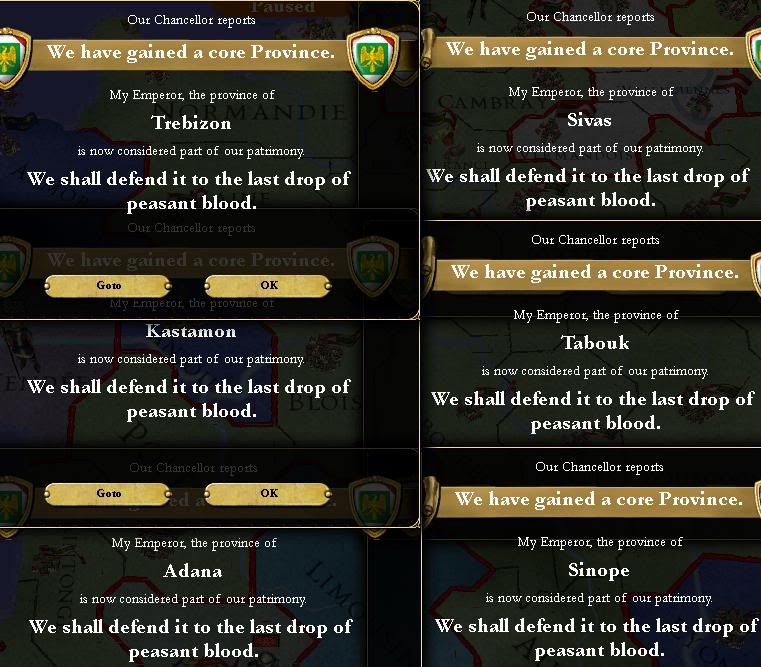
February, Italy gained new cores on a total of six provinces.
Late April, Sierra Leone finally reached 1,000 colonists, and the total population swelled to 7800+ when the local savages were bought off/convinced to become Italian citizens. A fortress was commissioned immediately.
September, Budjak's Orthodoxists had all converted to Catholicism. Meanwhile, Orthodox Zealots from Bosnia had invaded Dalmatia.
November, 6 Caravels from within Italy's Middle Eastern ports all sailed into the Gulf of Suez, to destroy the 2 Pirate barques and 5 galleys inside it.
By December, only 2 galleys remained of the Pirate fleet, and Italians all over celebrated the fact that the decades of piracy that had plagued the Red Sea provinces were finally over.
Days before New Years, the Zealots were defeated in Hum.
1529
February, the pirates had finally been finished off, and the Carrack fleet was ordered to repair after checking the entire Red Sea for pirates.
By March, outside the waters of Aden, the fleet of the "Ming" was encountered, but they were peaceful. Their nation could not be pinpointed thanks to their funny tongue, however. It was reasoned though, that the Ming were at war with Persia and the Arabic state of Haasa.
All the Arabic states - besides Yemen, of course - and Rajputana(which had long been deduced to be a potent force as they constantly fought Persia and had territories on the Arabic peninsula) were also involved in conflicts in and around the peninsula, but not with Ming.

Oman and Baluchistan had challenged the power of Songhai, the Turks, Rajputana, and Najd. Fortunately for them, Songhai and the Turks were isolated by Italian territories and distance and could not contribute troops. But would Rajputana gain anything from the conflict? That was what Italian bureaucrats wanted to know.
As ships repaired inside the port of Aden, plans were made to attack the pirates that had risen up in the Gulf of Suez again.
April, Ancona converted to Lombard culture, leaving Umbrian with only one province - that of Rome.
May, Hannover converted to Catholicism.
August, Altmark converted to Catholicism.
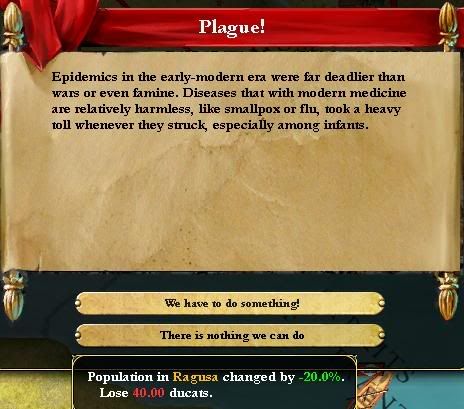
Grim events, those of a plague, cancelled out the greatness of the conversion of Altmark.
October, in a dispute, Italy pressed claims to Cornwall.
Mid-October, the Reformation vanished from Meissen with the efforts of the Jesuits.
It also became apparent that all along the eastern border with Persia, 51,000 Persian troops had gathered. It was believed that the Persians were considering an invasion of the Italian Empire.
December, France annexed Britanny. They chose to suppress all resistance in the Breton territories.
1530
January, rebels that had risen up in Bamberg were exterminated.
February, Italy pressed claims to Silesia, who had pressed claims to parts of Bohemia in the past.
September, the death of a Cardinal enabled Italy to control the entirety of the Curia.
December, Anhalt was converted, while claims were fabricated on the French crown's Catholic lands...
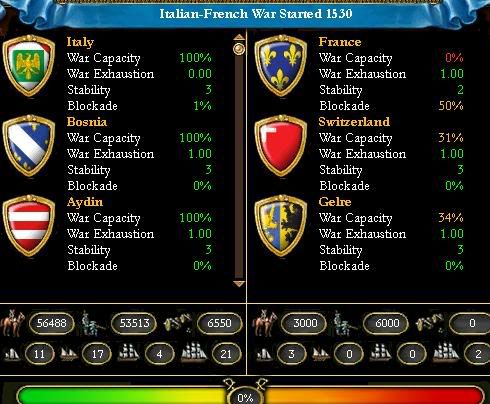
Gelre and Switzerland protected France, and together they had a combined army of 9,000 men, to the Italian alliance's 110,000+ soldiers.
Tani Coyote
Son of Huehuecoyotl
- Joined
- May 28, 2007
- Messages
- 15,193
Continental Europe north of Iberia is getting to look essentially Italian with only regional pockets standing in the way.
Wait until you see the numerous wars of rape raged in the 1530s against France, Austria and Trier, the largest powers within the Italian Empire!
Tani Coyote
Son of Huehuecoyotl
- Joined
- May 28, 2007
- Messages
- 15,193
Chapter XXXII: The Franco-Phony Empire(1531)
Spoiler :
1531
By January, Armor had been taken back from the Breton nationalists, but it was now in Italian hands. Gelre's army was more or less screwed in Utrecht, while Switzerland's army was ready to be cornered in Lombardia. Given the dire circumstances, the French offered a peace settlement of several ducats and renounced claims, but the Emperor declined, saying that only once the Catholics were under imperial protection would France be allowed to live in peace.
May, Anjou was finally seized, allowing all troops to move Eastwards against the Eastern half of France.
Gelre was annexed later in May, connecting the West German provinces to the French-Lowland part of the Empire through a narrow corridor through Limburg and Gelre. As well, the areas centered on the Rhine now found themselves surrounded on all sides by Italian lands.
July, 3,000 Italian troops perished thanks to the work of the French King in Franche-Comte and Bourgogne. Orders were given to take the rest of East France, and then punish the French.
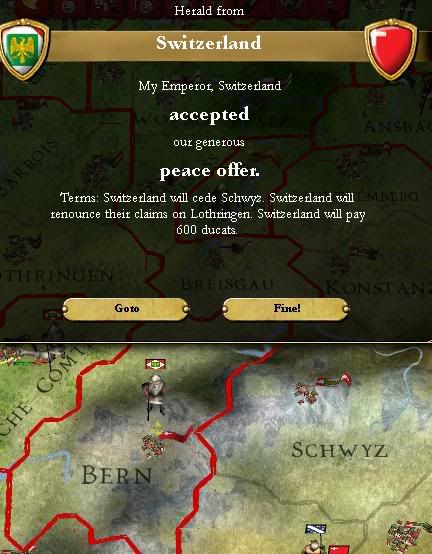
September, the Treaty of Bern did not re-vassalise Switzerland as many assumed would happen, but inflicted a far worse fate upon the Swiss people: they had to pay 600 ducats and cede half their country to the victorious Italian army.
A day later, Lyonnais was taken, and while the French had been humiliated and were willing to accept a complete surrender, the Emperor said no. He said he wanted to avenge the lives of all the Italians who lost their lives in the Eastern campaign, and so he ordered his general Simone Rovigo to attack the French King's personal force of 1,000 cavalry and 3,000 infantry in Bourgogne. He was to bring the heads of every enemy killed back to the court... even that of the French King.
By September 21, Henri III of France was fighting with 771 cavalry and 2,029 infantry against 7,551 cavalry and 16,978 infantry under Simone Rovigo.
The little coward of a King managed to flee to Bourgogne, but Rovigo gave chase with 7,500+ cavalry.
October, Italy pressed claims to Bosnian Osijek.
Later in October, troops at the victorious siege of Franche-Comte and the victorious Battle of Bourgogne learned from eachother that both had finished their goals simultaneously. The French King managed to escape Rovigo's hordes, but he was soon arrested in a nearby village when traders managed to barely recognise his face from a coin. Sent to Rome, the French King was forced to sign a humiliating peace treaty... or else the Emperor of Italy would execute him and all successors who refused to sign a treaty.
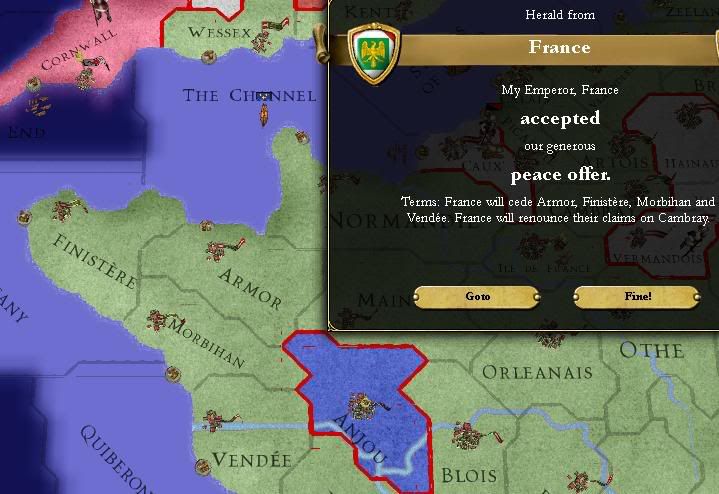
Naturally, Henri III sold out, and he parted with all of Britanny. Catholics had finally been expelled from the French Kingdom, but not in the way the French government wanted.
Within less than a year, the French had been disgraced, being forced to surrender half their country and their entire coastline.
And so, 1531 became a year that forever lived in infamy for all those proud of being French. Likewise, many Catholics celebrated the year, as Catholics all over had been freed from the grip of Protestant and Reformed governments, with a few exceptions such as religiously-chaotic Sweden.
December, Bamberg embraced Catholicism.
Tani Coyote
Son of Huehuecoyotl
- Joined
- May 28, 2007
- Messages
- 15,193
Chapter XXXIII: Centralising Germany, Part II(1532-1533)
Spoiler :
1532
January, the Italian treasury was flooded with new tax ducats.
...More importantly, war was declared upon Reformed Ansbach.

The Princes' Alliance formed anew, now composed of Pommerania, Prussia, Baden, Switzerland, and Thuringia, all supporting Ansbach against the Emperor.
By January 8, Ansbach's 1,000-man army had been obliterated.
Later in January, the main enemy force - that of Trier - was beaten at Metz in Italian France, with about 4,000 casualties on Trier's side and 1,000 on Italy's.
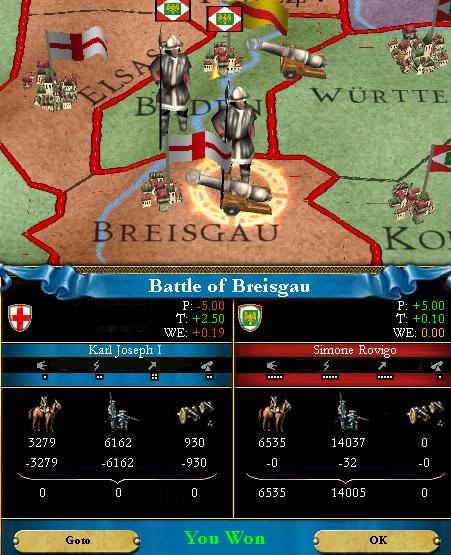
February, Simone Rovigo was rewarded with great wealth thanks to his spectacular victory over the main force of Trier's Karl Joseph I.
August, as the armies of Trier and Switzerland crumbled, Schwyz finally embraced Catholicism, abandoning it's former countrymen(who had persecuted them anyways for being Reformed and not Protestant).
August 31, Reformed Baden was annexed, the Emperor keeping true to his idea that no non-Catholic should keep independence if it was possible to avoid such an outcome.
September, the Red Sea provinces all became integral parts of the Empire...
October, Thuringia, Trier, and Ansbach were all totally occupied, though the Thuringians had managed to occupy Thuringia - outside their capital of Dresden.
November, Ansbach was annexed by Italy.
Later in November, one-province Pommerania was spared on the account of being Catholic, and it was accordingly vassalised and forced to renounce it's claims on it's old territory.
The Poles soon annexed Wallachia in late November.
December, with new government theories discussed in front of him by advisors, the Emperor ordered that Genoa and Venice both establish Constabularies.
December 8, Baden was converted to Catholicism.
1533
January, Thuringia accepted vassalisation to the Holy Roman Emperor.
February, Ansbach embraced Catholicism while Bern was occupied by Italy's armies.
March, as land tactics greatly improved, Gelre was converted to Catholicism, and for the first time in ages, the Italian Empire had religious uniformity.
July, as the middle of Prussia was occupied, Trier had a "Peasants' War."
Prussia was shortly afterwards vassalised and forced to pay a small indemnity of 25 ducats to Italy. Switzerland was next on the chopping block.
Switzerland was annexed immediately, and missionaries sent to get rid of the non-Catholic thoughts present there.
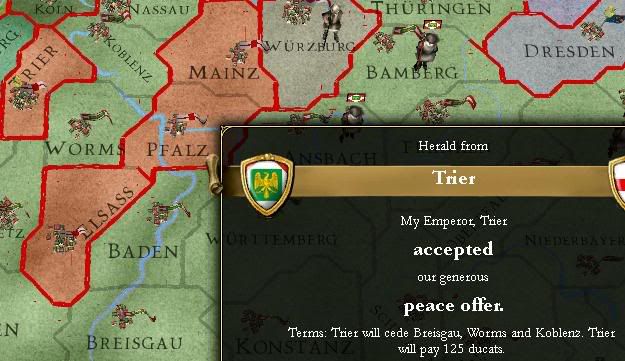
Soon, Trier was split in two by the signing of a treaty...
Yet another war of German centralisation had been completed, with the Emperor as the victor. But it had come at a high cost; Italy's reputation had been greatly tarnished(18.02), and it would take some time for it to recover...
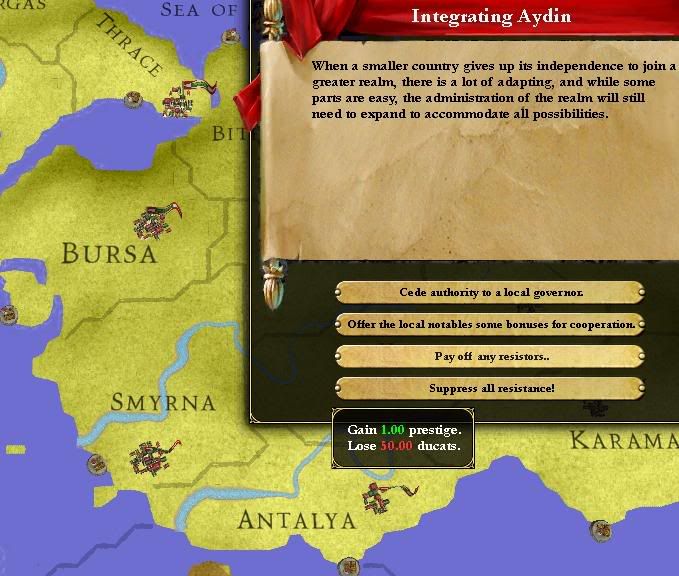
But reputation alone couldn't deter some from wanting to share in the glory of the Empire. Aydin accepted an offer of annexation after ages since they were inaugurated as Venice's first primary vassal-ally. Few resistors rose up as a result of both of Aydin's provinces being considered rightfully Italian, and many more were paid off.
Preparations were made to form alliances with the rest of Italy's vassals to strengthen the security of Europe - pro-Italian Europe, anyways.
August, less than a full month since it's shift to Italian control, Breisgau converted to Catholicism. This was attributed to how the province was Catholic not too long before Italy seized it, and the fact the inhabitants had nearly all been force-converted to Reformed Christianity.
October, Liege was attacked by Austria. Italy agreed to protect the small member state.

Liege was supported not only by Italy, but also by Guyenne, Toulouse, Armagnac, and last but not least, France.
November, Bern converted to Catholicism, but the Austrians had managed to occupy Steiermark.
Liege was annexed on November 13, 1533 by the Habsburg hordes.
December, the Cold War between Poland and Lithuania grew hotter, when Lithuania annexed Silesia.
...The Battle of Steiermark was also lost by Italy, despite having a cavalry advantage.
December 23, the heretics of Koblenz accepted Catholicism anew as the one, true faith.
Vienna fell on December 30, 1533. The fall of Vienna put the Austrians on thin ice.
IronMan2055
Korra 2011
Your act of putting up three chapters in a row when I need to read medieval texts is both annoying and relieving. 

Tani Coyote
Son of Huehuecoyotl
- Joined
- May 28, 2007
- Messages
- 15,193
If you're referring to schoolwork, 'tis my job.  If I have difficulty balancing out fun and games(EU3 suffers from "One More Year" syndrome) and school, then so must other people!
If I have difficulty balancing out fun and games(EU3 suffers from "One More Year" syndrome) and school, then so must other people!
I know how you feel though.. I have issues balancing reading AARs and Off-Topic with working on these annoying assignments now that the semester's end is nearing...
 If I have difficulty balancing out fun and games(EU3 suffers from "One More Year" syndrome) and school, then so must other people!
If I have difficulty balancing out fun and games(EU3 suffers from "One More Year" syndrome) and school, then so must other people!I know how you feel though.. I have issues balancing reading AARs and Off-Topic with working on these annoying assignments now that the semester's end is nearing...
IronMan2055
Korra 2011
More like a balance of school-work-and life, with no games. =P But then you can read all about it on my dA if you wish. =P
sophie
Break My Heart
If you're referring to schoolwork, 'tis my job.If I have difficulty balancing out fun and games(EU3 suffers from "One More Year" syndrome) and school, then so must other people!
I know how you feel though.. I have issues balancing reading AARs and Off-Topic with working on these annoying assignments now that the semester's end is nearing...
Less talk more updates!!
Great stuff. I'm getting EU3, HoI2 and Victoria for Christmas, but I don't think I'll be able to play EU3 until I return to my desktop in my dorm

Until then, I've been getting my fix reading this, it really is great stuff!
TheLastOne36
Deity
- Joined
- Jan 17, 2007
- Messages
- 14,045
You know there is a Victoria 2 coming out soon. You might want to hold on before getting Victoria. Also, there is HoI3. 

sophie
Break My Heart
You know there is a Victoria 2 coming out soon. You might want to hold on before getting Victoria. Also, there is HoI3.
Well, I got HoI2 over 3 because it's extremely cheap, the same with Victoria, as well as EU3. Also I heard some bad things about HoI3, but from the sounds of the paradox fora, it seems like all of paradox's games are really bad on release day.
Has anyone played EU Rome?
Tani Coyote
Son of Huehuecoyotl
- Joined
- May 28, 2007
- Messages
- 15,193
Chapter XXXIV: Spanking Austria(1534-1535)
Spoiler :
1534
January, the Battle of Steirmark destroyed the Austrian army near Vienna. Steiermark was quickly retaken in an assault.
February, Italy pressed claims to Lugansk, owned by Astrakhan.
March, Worms converted to Catholicism.

May, while Austria had occupied Cambray, Oxfordshire and Wessex, it suffered a massive defeat at Vermandois.
September, Italy won the Battle of Wessex against the Austrian King. Both forces were pure infantry, with Italy having a slight advantage in numbers, leadership, and cannons. General Anselmo Modigliano, the leader of the English campaign, arranged for the Emperor to send him a few thousand cavalry soldiers from France to set the odds in his favor...
It soon became apparent why Italy had been struggling in some battles: her maintenance had stayed at 50 percent. While angered, the Emperor immediately remedied this.
October, after a defeat at Gloucestershire, the Austrian forces - composed of about 3,000+ infantry - fled to Wessex, where 4,250 cavalry tore them to pieces. Austria had lost it's entire army.
December, Cambray was the only province remaining under Austrian control.
Nis converted later in December.
1535
January, the fall of Cambray gave Italy complete control over the Austrian Empire.
July, the Austrians offered Caux on a platter to France in exchange for peace, and the French naturally took it.
August, with a full treasury, the Emperor initiated a massive development program, building temples in territories occupied in recent wars as well as in overseas colonies.
September, Italy pressed claims to Kouban, wedged between Azow and Lugansk, both of which were considered legal territories of the Empire.
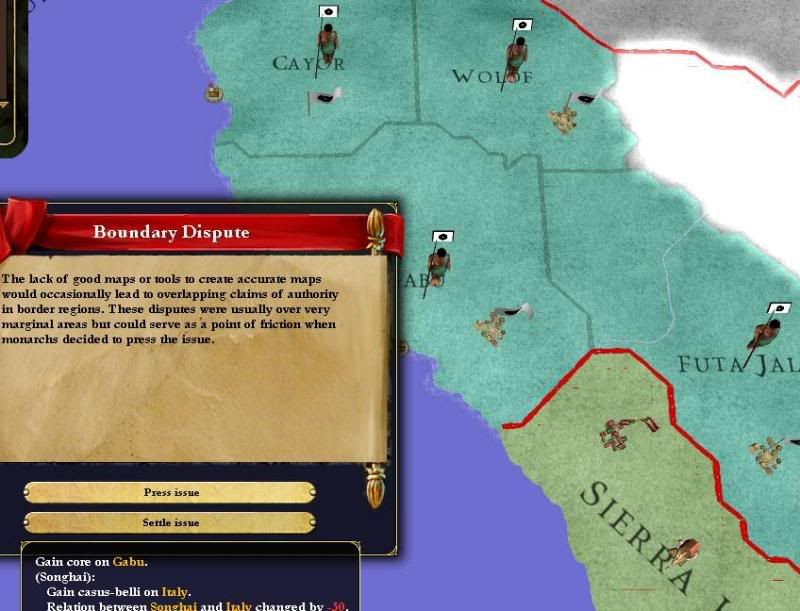
December, in response to the gathering of 33,000 troops along the border, Italy pressed claims to Gabu along the West African coast, owned by Songhai.
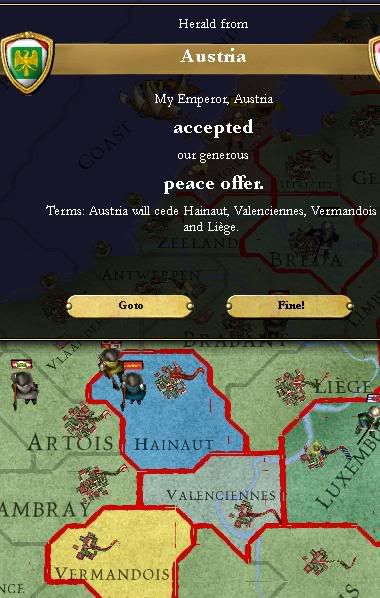
When it became apparent no separate peace treaties would be signed, it was decided to make an overall peace. Italy took Liege, Toulouse took Valenciennes, Armagnac took Vermandois, and Toulouse took Hainaut. Together with the cession of Caux, each of the powers of the anti-Austrian coalition had gained one province out of the war, splitting the Austrian Netherlands equally. The Austrian Netherlands were no more...
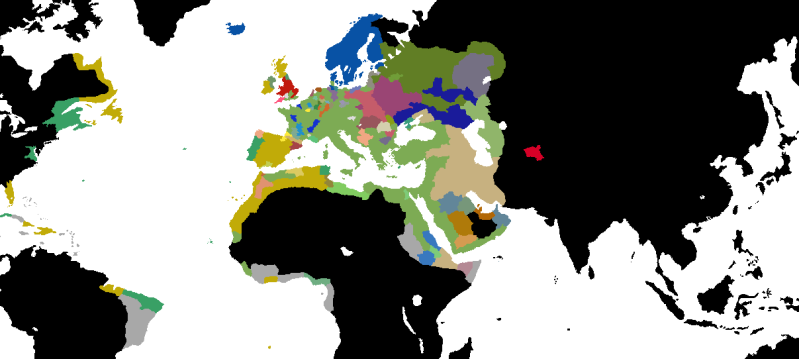
Tani Coyote
Son of Huehuecoyotl
- Joined
- May 28, 2007
- Messages
- 15,193
As a preview for next time...
Let's just say I've gone on some Caribbean + African adventures!
Let's just say I've gone on some Caribbean + African adventures!
IronMan2055
Korra 2011
Well played cliffhanger. Well played indeed....
Tani Coyote
Son of Huehuecoyotl
- Joined
- May 28, 2007
- Messages
- 15,193
Chapter XXXV: All Your Base Are Belong to Us, Infidel(1536-1541)
Spoiler :
1536
January, a fleet of 10 cogs was ordered to transport 20 troops to the colonies near Songhai for a predictable reason...
October, 9,000 cavalry, 9,000 infantry and 2,000 cannonmen had been positioned around Songhai. Military maintenance surged upwards, and a month was given as a grace period...
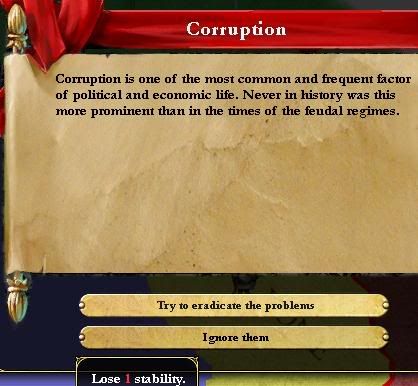
Italy soon suffered it's first stability hit in decades when the Emperor tried to purge corruption from the ranks of the government.
November, war was declared upon Songhai. They possessed 58,000 soldiers alone. Najd, Algiers and the Turks would swell this a tad as well.
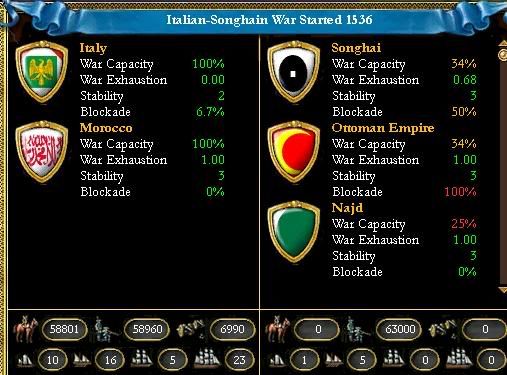
All together, the enemy forces had 63,000 infantry. As Songhai was at land tech 2 to Italy's 18, it was bound to be a massacre.
Late December, the 3,000-man Turkish Army was destroyed.
1537
By March, Algiers and three of Songhai's provinces were occupied, while the total enemy forces had been cut down to 10,000+ thanks to the massacres of West Africa(in two cases, 9-10,000+ enemies had been cut down by fire).
May, a new advisor - a diplomat - was hired to replace one of the three ancient missionaries who had finally passed away.
Peace was soon signed with Najd, with no concessions from either side.
August, the Ottoman "Empire" was wholly occupied.
December, as more emphasis was placed on land tactics to balance out the armed forces, naval officers retired.
And shortly afterwards, it was discovered uniforms were of substandard quality...
1538
January, Saxony converted to Reformed Christianity. At the very least, this would make absorbing them easier.
August, Algiers was finally annexed.
September, cores were gained on much of the former Bavarian Duchy.
November, as Modigliano's health began to fail, his replacement, Emmanuele Filiberto di Busca, was commissioned.
1539
June, with all of Songhai explored, troops were ordered to retreat until a treaty was signed.
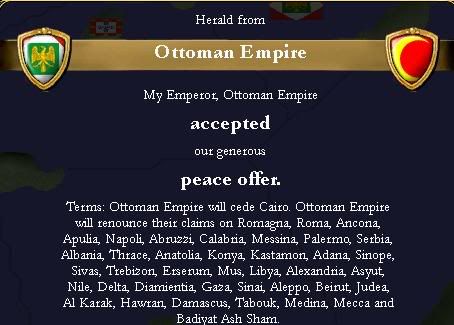
The Turks signed a peace treaty, with horrific results. They had to cede Cairo and renounce so many claims that what few claims they had left were scattered across Europe, Asia and Africa. The Sultan also had to move his residence to Tigre, smushed between Persian and Ethiopian territories.
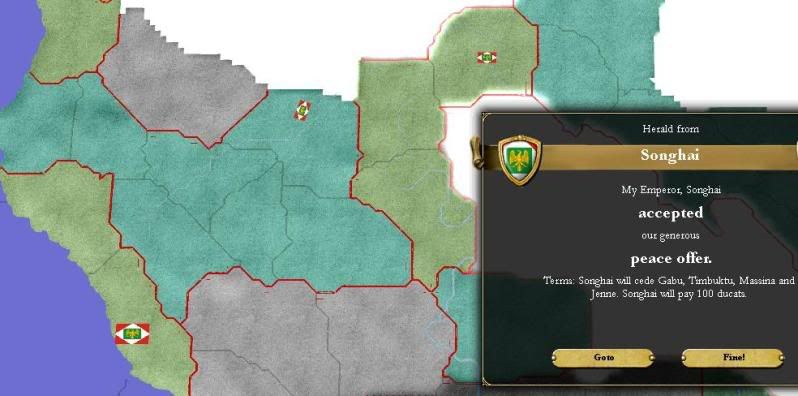
The Songhai Sultan was brought to the table afterwards, and forced to cede few provinces, though his realm was cut in half and his valuable trade center seized by Italy.
With an expanded colonial range thanks to the acquisition of the key port of Gabu, colonists were sent to the Caribbean as well as further down the African coast to give the "Timbuktu territory" a coastline.
Before the dust had even settled, however, the Emperor ordered an assault on the coastal, pagan country of Benin. They possessed a center of trade that was taking away from Timbuktu's profits, and they had to be dealt with accordingly.
November, war was declared upon Benin.
December, the Castilians and Portuguese were surprised to discover that the Italians had reached Trinidad, and had established a new settlement there.
1540
January, cores were acquired on territories from the first victory against Austria, such as Brabant and Antwerp.

Natives were soon seen observing the colonists of Trinidad, and war was declared upon them, or at least a few weeks of skirmishes. Accordingly, the colony grew as some natives defected to Italy.
February, Algiers embraced Catholicism.
February also had the discovery of substandard cloth in the uniforms, again...
March, reports showed that Trinidad was a good spot for the newly-introduced Tobacco plant, pioneered by the Portuguese and Castilian colonies.
April, General Modigliano finally defeated the ruler of Benin in the last free province, placing it under Italian occupation.

Benin was annexed without a second thought. Their trade center was immediately dismantled in favor of Timbuktu, which Italy could monopolise and profit far much more from occupying.
To repair the prestige loss, Kosovo, Edirne and Thrace were integrated into the Holy Roman Empire.
...Songhai saw through Italy's tactics and, determined to avoid trading through it's enemy's centers, established a new center of trade near the Italian border. Fools.
Shortly after Benin's absorption into the Italian Empire, Mutapa, it's ally, accepted a white peace.
June, a new colony was established in Worodugu, connecting the Timbuktu provinces to the Gold Coast.
September, Castile's colony of Yucatan was discovered... as well as the "Maya" nation. Plans were made to destroy this nation of foul savages, and troops were mobilised under General Di Busca to be sent overseas.
October, General Anselmo Modigliano died.
December Beninese Bonny converted to Catholicism, and a new Lombard province was crafted accordingly.
1541
February, Massina was converted to Catholicism, becoming a center of Christianity in the middle of Sunni Songhai.
March, Calabar in Benin was converted to Catholicism, spreading Lombard culture further.
Later in March, claims were pressed to the Hungarian capital.
June, the province of Benin converted, eliminating the pagan thoughts of the old country of Benin.
December, Mali Jenne converted to Catholicism.
Tani Coyote
Son of Huehuecoyotl
- Joined
- May 28, 2007
- Messages
- 15,193
Chapter XXXVI: Centralising Germany, Part III(1542-43)
Spoiler :
1542
January, war was declared upon Cleves.
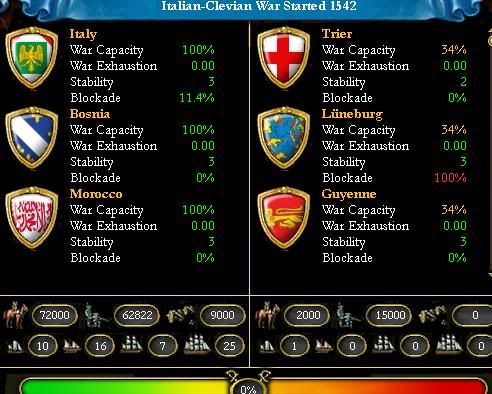
While Luneburg, Trier, and Guyenne formed a new Princes' Alliance, their efforts would be futile, just like the previous alliances'.
January 10, 4,000 men under the employ of Guyenne were exterminated in Hainaut.
By April, while Italy had lost Worms to Trier and had somehow lost the Battle of Hannover despite better leadership and cavalry, Guyenne was out of the war, ceding Hainaut and Rouerge.
August, Ottavio Barilla, one of the three legendary priests, died. Only one remained from an era where conversion was always a certainity.
To replace him, a level three High Judge was appointed to the Court.
September, a third fortress fell to Trier, while two others were occupied by enemies.
November, Cleves was annexed.
1543
While chaos engulfed Germany...
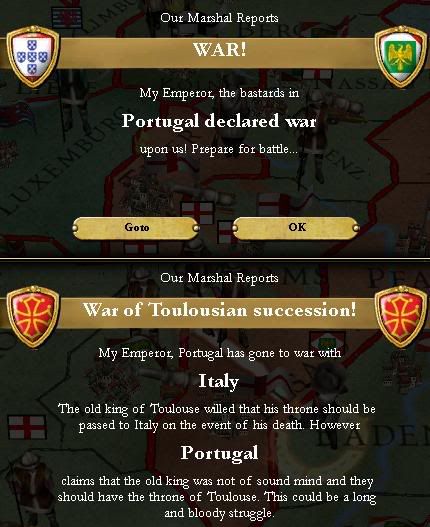
The King of Toulouse died, passing his throne to the Emperor of Italy. The Portuguese, however, contested this claim.

Accordingly, Galicia, Castile, Oyo and England all aligned with Portugal, while Italy had only Morocco and Bosnia to back her. While Italy's side enjoyed far more cavalry forces, it was at a serious disadvantage navally. All ships were called back into port; the enemy would defeat Italy's pirates.
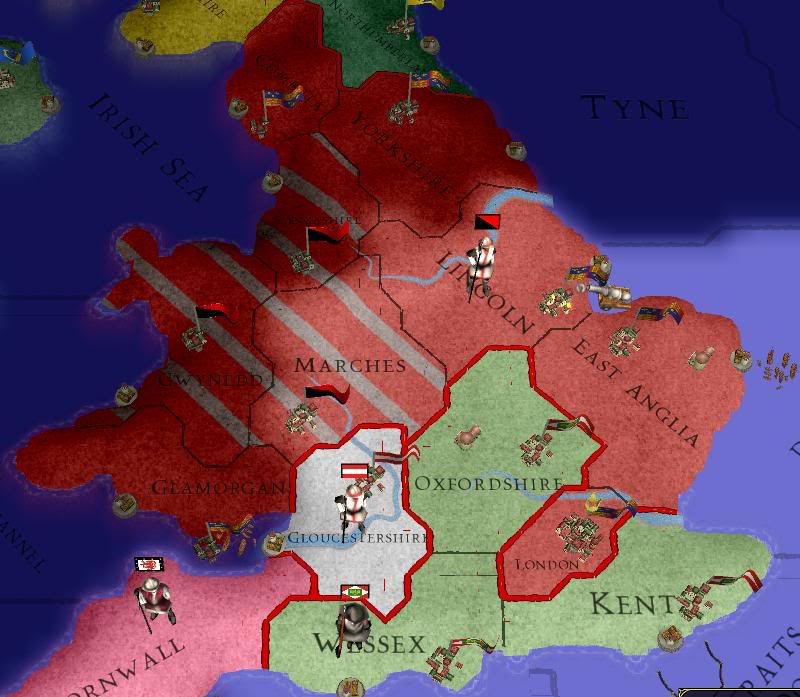
Things were not so grim, however. England was in shambles, and troops were expected to easily take London and East Anglia, to take East Anglia in the treaty. This would cause her 46+ Carracks to get out of the war.
April, Romeo Spinola was appointed as a general to help win the war in Africa, and his first objective was to seize the Castilian colony of Ivory Coast.
May, Oyo was annexed.
July, di Busca was defeated by the Castilians at the Battle of Fez, which had thousands of casualties on both sides.
August, with London and East Anglia under his control, Emperor Vittore I forced the English to hand him the port of East Anglia along with it's prestigious university in exchange for peace.
October, Brunswick and Trier capitulated, with no provinces besides their respective capitals left outside Italian hands.
Full effort could now be focused on the enemies. As the Castilians and their lapdogs had devoted most of their time to Africa, attrition was not only high, but Iberia was likely undefended. Troops invaded under General Rovigo.
Tani Coyote
Son of Huehuecoyotl
- Joined
- May 28, 2007
- Messages
- 15,193
Chapter XXXVII: Iberian Adventures(1544-1548)
Spoiler :
1544
By January, the province of Girona - formerly Aragonese but Aragon had been annexed by Portugal - was occupied. The Portuguese and Castilians were putting up heavier resistance than expected.
September, Valencia fell. All of the former Aragonese Empire besides Alicante was firmly under Italian rule.
October, Madrid was captured as Gabu was converted to Catholicism...
December, Timbuktu embraced Catholicism.
1545
January, news arrived that the Castilians were at war with Ireland and Granada, who saw Italy's war effort as a means of gaining their own territories in Ireland and Andalucia, respectively.
February, as Hainaut was converted, troops were ordered to invade Galicia.
April, Galicia was occupied. Within days, they agreed to become an Italian vassal, and they also gave control of Fez back to Morocco.
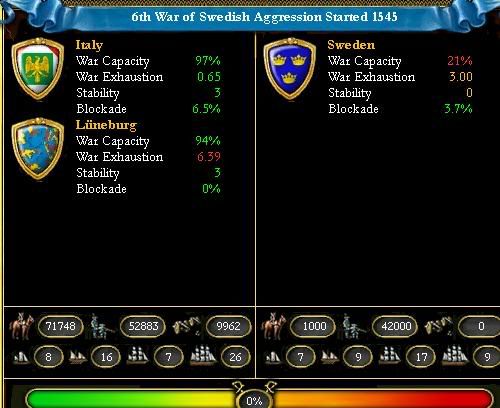
May, Sweden invaded Luneburg, and Vittore I agreed to defend it...
With a war with the Great Blue North official, it was necessary to finish off the Portuguese and Castilians.
The Swedes had 23,000 soldiers present in Hamburg, and so it was imagined Northern Germany would fall under Swedish occupation while troops were hired and the war in the south settled. The Austrians also joined in with their smaller army...
It soon became apparent that while Luneberg itself was doomed, it had sent a goodbye present to Sweden: Poland, England, and the Papal State all intervened on it's side.
By September, 4 Italian provinces were under the rule of Sweden, and so, Isodoro Galilei was ordered to take a recently-constructed force from Central Germany and destroy the Swedish Army under Gustav I Adolf.
1546
By September, the Swedish King had been defeated, but not crippled. His army remained sizeable, but his grip on the German provinces was slipping. To make matters worse, his realm suffered a stability hit thanks to Italian espionage, putting him down at -1 stability.
Later in September, the last fortress of the Portuguese homeland was occupied.
1547
February, despite controlling about 3 of Italy's provinces, the Swedes offered a white peace. Not only did Italy refuse, but it signed a peace treaty with Austria, forcing them to exile themselves to their lone territory of Gloucestershire while ceding Vienna to Italy.
March, with no combat in the near future, a military reform was organised that converted Italy's Landsknechten into Maurician Infantry. The blue, spiky leader of the Underground - still alive, of course, being immortal - was glad that they chose the name "Maurician" as the name of choice for the new infantry regiments.

Late August, while the Swedish King had managed to occupy an impressive number of Italian territories, one of his largest armies was destroyed at Altmark. Countless regiments were lost, and Galilei was order to liberate Italy's territories. Sweden's remaining troops totalled only about 11,000 men.
October, Cordoba and the whole of the Castilian homeland was occupied.
1548
April, Sweden accepted a peace treaty, surrendering Hamburg and Luneberg. At long last, the Swedes have been driven out of Germany.
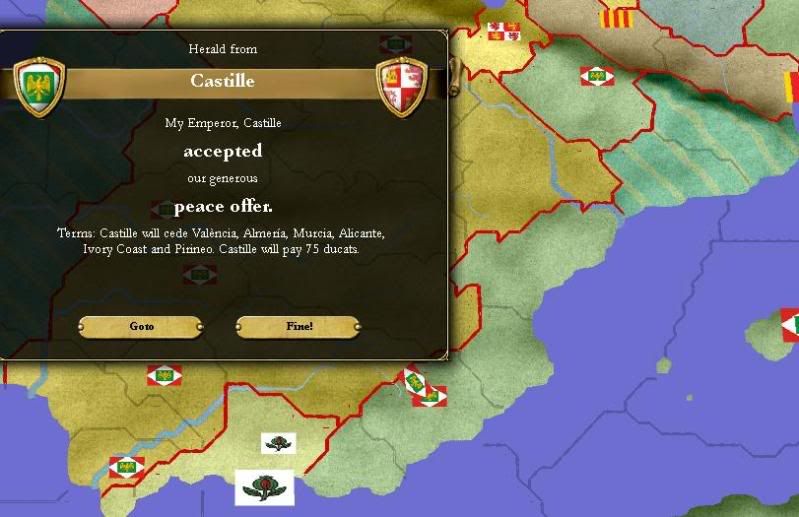
June, Castile was freed from the Italian yoke, but only after signing a treaty turning their Eastern coastline over to Italy. They also had to part with some ducats and their colony on the Ivory Coast.
Mere days after the treaty was signed, Castile informed the world that a Local Pretender had risen up inside it's empire. This pretender was located in Atlas, possessing 3,000 soldiers.
November, the fall of Tunis, the former heart of the Carthaginian Empire and great Rome's first conquest, was occupied by Italy.

Accordingly, they signed a treaty where they renounced their claims upon the throne of Toulouse(allowing Vittore I to place himself upon it), gave a small amount of ducats, ceded Braganza, Tunis and Rhodes, and finally released the "Shawnee."
And so, Italy had triumphed through three bloody, successive wars: One against the German powers, another against the Portuguese and their allies, and a final one against the Swedes.
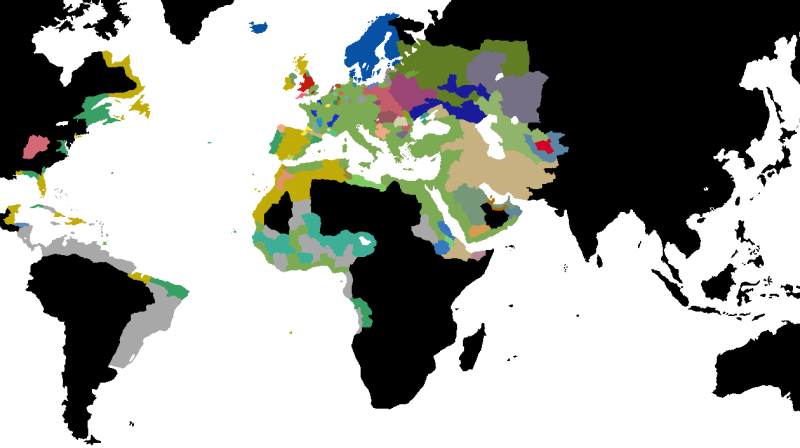
Similar threads
- Replies
- 8
- Views
- 1K
- Replies
- 5
- Views
- 1K
- Replies
- 0
- Views
- 549
